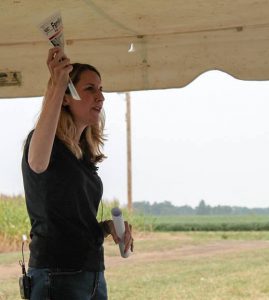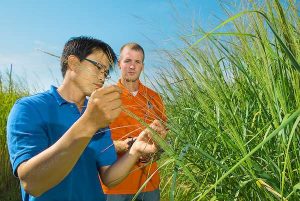As global warming evidence mounts, Illinois farmers adapt to changes
By Tim Alexander For Chronicle Media — August 25, 2017
Climate change is going to force Illinois farmers to make adjustments to their growing schedules, according to the University of Illinois College of Agriculture. Corn planting, for instance, may need to be divided into two to avoid wet conditions in April and May. (Photo courtesy of Illinois State Water Survey)
A new federal climate report says the world is already feeling the effects of climate change, with 15 of the last 16 years boasting the highest average atmospheric temperatures in modern history.
Average U.S. air temperatures have risen dramatically over the last four decades, according to a draft of the report — which has yet to be approved by President Donald J. Trump — obtained by the New York Times.
The report also concludes that emissions of greenhouse gases by man-made sources will continue to boost global temperatures in the coming years, with cold waves less common.
While the conclusion of scientists from 13 global nations who contributed to the report have been dismissed by Trump as a “hoax,” Illinois farm groups and the U.S. Department of Agriculture have been educating farmers on how to adapt their practices in response to climate change for many years.
Those who seek to educate farmers on the effects of climate change — including the Illinois Farm Bureau (IFB), USDA Natural Resources Conservation Service (NRCS), and many others — must often walk a fine line when approaching farmers about what is often referred to as global warming. After all, the farm sector voted overwhelmingly in support of Trump, and other climate change deniers, in the last election.
But however they voted, it appears that a majority of Illinois farmers (especially younger ones) are already adapting their production practices to climate change by adding soil, water and nutrient conservation systems to their operations, an environmental expert with Farm Bureau noted last week.

Lauren Lurkins, director of natural and environmental resources for the Illinois Farm Bureau, talks with farmers in Wayne County earlier this month. The words “climate change’ can be politically charged in the agricultural community. (Photo courtesy of Wayne Co. Farm Bureau)
“We don’t have to use the words ‘climate change,’ we can talk about weather variability — that is not as politically charged. Everybody knows that weather is different all over the state, growing season after growing season. It’s always something (farmers) are adapting around,” says Lauren Lurkins, director of natural and environmental resources for the IFB.
“In the northern part of the state the governor is declaring disaster zones because of floods. Other parts of our state have not seen rain in what seems like forever. Whether the issue is too much or not enough water, everything is just ‘different’ these days,” she said.
Advising farmers on how to adapt to climate change is a regional challenge due to vast production differences between farm operations in the north, central and southern portions of the state, Lurkins continued.
“We don’t have one ‘single’ message on climate change or on the weather variability, but there are some awesome resources that exist in our state. We use our communications platforms to connect our farmers with localized information, including weather and soil moisture information. It can come from an app on their phone or on our website, or our weekly membership publication (FarmWeek),” she said.
For instance, the Illinois Water Survey maintains the WARM (Water and Atmospheric Resources) program, which provides localized groundwater, soil moisture, soil temperature and other information geared towards farmers. The program enjoys the support of a monitoring system that gathers data from wells and weather stations across the state. The WARM program may be accessed at www.isws.illinois.edu/warm.
In addition, a new tool called the “Growing Degree Day Calculator” is a land-grant university backed resource that farmers are “really liking,” according to Lurkins.
The calculator, available at www.isws.illinois.edu/warm/cropdata/cropddcalc.asp, advises farmers on historical soil temperatures and conditions in their areas in order to prevent untimely nutrient applications.
“There is a high level of interest among our members to bring technologies like these to their cell phones,” Lurkins said.
The USDA’s NRCS offers a vast array of programs and resources for farmers interesting in adapting production practices on their “Climate Change” page at nrcs.usda.gov/wps/portal/nrcs/main/national/climatechange. NRCS’ Conservation Innovation Grants are offered annually to stimulate and encourage adoption of innovative conservation measures that address greenhouse gas mitigation and carbon sequestration, soil health, drought adaption and irrigation management.

The University of Illinois College of Agricultural and Consumer Economics issues reports and conducts studies on the effects of climate change on agriculture. The most recent reports is entitled “Climate Change May Confuse Plant Dormancy Cycles.” (Photo courtesy of U of Illinois)
In addition, NRCS’ “Building Blocks for Climate Smart Agriculture and Forestry” is USDA’s framework for helping farmers and ranchers respond to climate change.
The University of Illinois College of Agricultural and Consumer Economics (ACES) issues reports and conducts studies on the effects of climate change on agriculture. ACES’ most recent issuance, “Climate Change May Confuse Plant Dormancy Cycles,” released in this month (August), examines the effects of annual temperature fluctuations on switchgrass and prairie cordgrass, both native perennial grasses grown by Illinois farmers for biomass.
Jim Angel, Illinois State Meteorologist with the Illinois Water Survey, is advising farmers that a long-term trend shows springtimes becoming warmer and wetter. So how does agriculture respond?
“From a water quality standpoint, we talk about practices that reduce (crop) nutrient losses. For example, farmers should consider not putting all of their their nitrogen supply out in the fall and never looking back,” said Lurkins. “We want them to move more toward a spoon-feeding of nitrogen to the crop. Corn uses the most nitrogen at the end of the growing season, so farmers are losing money season after season.
“We also encourage using cover crops in corn and soybean rotations, whether it is to sequester any nutrients remaining in the field or for soil health. Some of the farmers are willing to try this out, and I am seeing that their soil is maintaining more moisture in their fields, and can maybe withstand times of drought a little better,” Lurkins said.
Encouraging farmers to adopt new conservation practices may be the key to mitigating some of the effects of global climate change, but to convince some farmers — especially those nearing the end of their farming days — to adapt to new, sometimes costly production practices, proponents such as Lurkins sometimes rely on the old carrot and stick routine.
“Once farmers realize that these conservation measures actually, in the long run, increase their profits through lessening their use of inputs like nutrients, the interest increases and they share that news with other farmers,” she said.
— As global warming evidence mounts, Illinois farmers adapt to changes —



